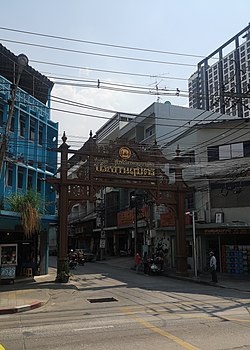world.wikisort.org - Thailand
Bang Sue (Thai: บางซื่อ, pronounced [bāːŋ sɯ̂ː]) is a khwaeng (subdistrict) of Bang Sue District, in Bangkok, Thailand. In 2020, it had a total population of 79,405 people.[2]
History
In the early Rattanakosin era corresponds to the King Rama I's reign, Nguyễn Ánh who escaped to live in Bangkok had escaped again. Therefore, relatives who traveled from Laos came to look for them. The king therefore decided that these two Annamese families should settle and live in a place far from the sea so that they would not escape again, that was Bang Sue.
Bang Sue, also colloquially known as "Bang Pho" (บางโพ), what is now four-way intersection, where Pracharat Sai 1 cuts across Pracharat Sai 2 Roads near Wat Bang Pho Omawa, an eponymous. It is also the name of surrounding area.
Bang Pho was mentioned in Nirat Phu Khao Thong (นิราศภูเขาทอง, "journey to golden mount"), the travelogue of the poet Sunthon Phu. In the literature described the Annamese in Bang Pho have a career selling shrimp and fish. Evidence that once Annamese lived here is a Wat Anam Nikayaram, an Annamese Buddhist temple near Bang Pho Intersection today.[3]
In 2009, the northern area was completely separated into a subdistrict, namely Wong Sawang.[3]
Geography
Bang Sue is the southern part of the district. The west bank is all connected to the Chao Phraya River. It borders Wong Sawang to the north (Southern Railway Line is a borderline), Chatuchak to the east (Khlong Prapa is a borderline), Thanon Nakhon Chai Si to the south (Khlong Bang Sue is a borderline), Bang O (across the Chao Phraya River) to the west.
Administration
Bang Sue consists of 24 communities.[3]
Pop culture
Bang Sue or Bang Pho is the setting of a Thai disco song, titled 'Sao Bang Pho' (สาวบางโพ, "Bang Pho girl"). It was sung by Direk Amatayakul in the year 1982.[4]
References
- Administrative Strategy Division, Strategy and Evaluation Department, Bangkok Metropolitan Administration (2021). สถิติกรุงเทพมหานครประจำปี 2563 [Bangkok Statistics 2020] (PDF) (in Thai). Retrieved 27 November 2021.
{{cite web}}: CS1 maint: multiple names: authors list (link) - "Population statistics 2020" (in Thai). Department of Provincial Administration. Retrieved 12 October 2021.
- "ข้อมูลทั่วไป สำนักงานเขตบางซื่อ" (PDF) (in Thai). Retrieved 3 March 2022.
- Indy man (4 March 2020). "38 ปี กับเพลงสาวบางโพ ..." [38 years with Sao Bang Pho song]. blockdit (in Thai). Retrieved 3 March 2022.
Другой контент может иметь иную лицензию. Перед использованием материалов сайта WikiSort.org внимательно изучите правила лицензирования конкретных элементов наполнения сайта.
WikiSort.org - проект по пересортировке и дополнению контента Википедии

